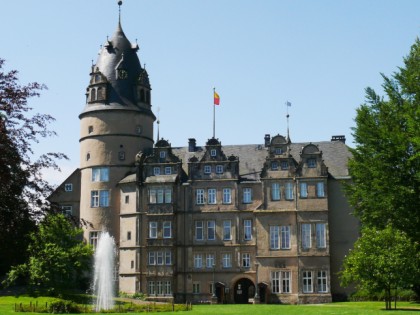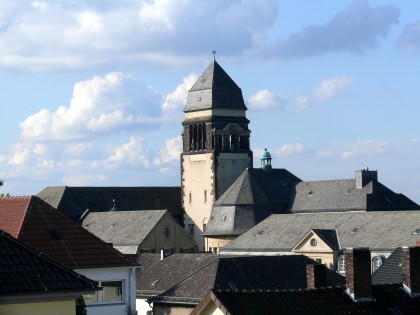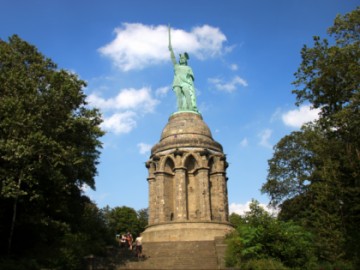Detmold was first mentioned in official sources in 783. The next important milestone is 1263, when Lord Bernard III of Lippe fortified the settlement with stone walls and granted it a city status. In the XVI century Detmold became the permanent residence of the counts of Lippe.
Unlike many cities in Germany, Detmold was fortunate enough to fully preserve the old city during both world wars. The historical center comprises more than 500 old houses from different eras and of different styles. Among them are the typical German half-timbered houses, later baroque buildings and monuments of classicism. But there are also examples that are unique for the region's architecture. Detmold is one of the Westphalian cities, where the architectural style known as Weser Renaissance (Weserrenaissance) flourished. It was applied not only in the construction of socially significant buildings - palaces, churches and town halls, but also of houses of the well-off townspeople and peasants. Buildings of this style are distinguished by intricate gables, stone facing in a rustic style and lots of bay windows. The most impressive building in the Weser Renaissance style is the Princely Residence of Castle of Lippe (Fürstliches Residenzschloss). Although the castle is still used for its intended purpose, part of it is open for tours. Tourists have a lot to look at: spacious halls and salons of the castle are decorated with unique tapestries, chandeliers and ceiling paintings. One should also pay attention to the collection of porcelain and hunting weapons.
The Higher School of Music is the heart of city life. It was founded in 1946 on the initiative of the outstanding cellist and teacher Hans Münch-Holland. Talented students from around the world study there. The conservatory has 10 buildings with modern facilities for rehearsals, concerts and recordings. The main building is located in the former “new palace“ (Neuer Palais) built in 1718. It is surrounded by a beautiful palace garden (Palaisgarten) with unusual fountains and ponds- a charming place to catch your breath after running around the tourist attractions.
At the local office of tourism you can enroll on a tour on the role of women in history of Detmold and the Principality of Lippe. An interesting fact: one of the most progressive rulers of Lippe was a woman – Princess Pauline of Anhalt-Bernburg . From 1802 to 1820 she was the regent for her minor son. Inspired by the example of Napoleon's wife Josephine de Beauharnais, in 1802 she opened Germany's first daycare center in Detmold. Moreover, unlike the French centre, where they admitted only children of unmarried mothers, in Demold the offering was also to married couples, if both parents had to work. In 1809, Pauline abolished serfdom despite the protests of the nobility on the territory of Lippe, and in 1819 she introduced the first constitution of the principality. One of the main streets of Detmold – Paulinenstraße- was named in honor of Princess Pauline.
Being in Detmold one should include familiarization with traditional Westphalian cuisine in the gastronomic program. For example, Lippischer Pickert - potato with yeast dough. Originally, this dish used to be for the poor, but is now served as a local delicacy. The pancakes can be eaten spread with butter, plum or apple puree, jam or Nutella, but slices of smoked liver sausage (Leberwurst) are the classical side dish for it. Leberwurst is also one of the favorite dishes of the locals. Another popular dish in Westphalia-Stippgrütze also called Wurstebrei - is worth a special mention, too. Barley groats, mixed with scraps of pork and offal, usually the heart, kidneys and liver form its basis. All this mass is boiled with salt and spices and goes into a meat grinder. The mince is cooled till complete gellation. Due to high fat content, the dish can be stored for a long time, so in the past it was often frozen to be used over winter. Impressionable foreigners included Wurstebrei in the list of "the most disgusting looking dishes" in a tourist forum. But if food appearance is not your determining factor, this unusual delicacy is worth tasting. After all, it is sausage mashed into puree and Germans are experts of sausage. From vegetables kale (Grünkohl) and rutabagas are highly appreciated in Lippe, like in all of Westphalia. The latter is even styled with Lippe pineapple. Rutabagas are often added to a thick soup (eintopf) or puree is made with them. Local vegetarians say very plausible schnitzels are made from turnip.
In short, good-quality food, interesting and varied architecture, rich calendar of cultural events, the Weser Renaissance, two unique bird sanctuaries - all of these are worth including in the travel program to Detmold in Germany.












 Parks and recreation
Parks and recreation
 Museums and Exhibitions
Museums and Exhibitions
 Architectural Monuments
Architectural Monuments
 Other places
Other places



